
AI Show-Off: Crafting Agents with OpenAI and OneAI
A step-by-step tutorial for Choosing the Best Fit for Your Business Needs
Introduction
AI agents, “GPTs” included, are no longer mere glimpses of a futuristic tomorrow. They're actively shaping our present, revolutionizing businesses, streamlining operations, and even infiltrating our personal lives. These agents are redefining interaction and efficiency, leaving an indelible mark on the digital landscape. Amidst this, OpenAI's marketplace emerges as a hub for accessing a variety of GPT models, reflecting the growing demand for versatile AI solutions.
In the midst of this transformative wave, two AI agents stand out: OpenAI's GPTs and OneAI's OneAgents. Each brings a unique blend of capabilities and applications, making them game-changers in their own right. This article takes you on a journey through the world of GPTs and OneAgents, offering a balanced perspective on their impact and potential.
{{cta}}
Unpacking GPTs and OneAgents
Before we explore the unique features of OneAgent and GPTs, let's clarify what an AI agent is. For those who might only have heard the term, an AI agent is essentially a digital assistant, powered by artificial intelligence, designed to understand and interact in human language. These agents can automate responses, provide information, and assist with various tasks, acting as smart, virtual helpers.
At first glance, GPTs from OpenAI and OneAI's OneAgent might appear to offer similar functionalities. Both are AI agents, but their unique strengths and applications set them apart.
GPTs
GPTs, or customized versions of ChatGPT by OpenAI, represent a significant advancement in AI conversational technology. They are tailored to understand and generate human-like text, making them versatile for a wide range of applications, from creative writing to customer support. With their deep learning capabilities, GPTs can offer nuanced and contextually relevant interactions, adapting to various user needs and scenarios.
Key features of GPTs include:
- Advanced Language Understanding and Generation: Capable of handling complex language tasks, from composing emails to generating creative content.
- Customizable Interactions: Users can tailor the agent’s responses to fit specific scenarios or topics, enhancing relevance and efficiency.
- Versatile Application: Ideal for a wide range of uses, including customer service, content creation, and personalized learning tools.
- API Integration: Provides the ability to integrate with other systems and applications, enhancing functionality and adaptability.
- User-Friendly Interface: Designed for accessibility, allowing users to easily interact and manage their AI agent.
- Continuous Learning: GPTs can learn and adapt over time, improving their responses and interactions based on user input and data.
- No Code Solution: Enables users to customize and deploy AI agents without the need for coding expertise, simplifying the process of creating and managing AI-powered tools.
Considerations:
- Potential for "hallucinations" or generating factually incorrect information.
- May require more effort in prompt engineering for optimal results.
OneAgent
OneAgent by OneAI is a powerful AI agent tailored for factual accuracy and business applications. It delivers factual answers, free from hallucinations, and can respond to customer queries with references to source documents. OneAgent is versatile, able to learn from PDFs, video, audio, websites, or internal systems, and offers deep analytics on user interactions. It's fully customizable, allowing businesses to fine-tune its behavior to their specific needs. OneAgent stands out for its reliance solely on provided content, ensuring high accuracy and relevance.
<< Download the OneAgent WordPress Plugin >>
Key features of OneAgent include:
- Uses Power of GPT: Leverages the advanced language understanding and generation capabilities of OpenAI's GPT models, ideal for complex and nuanced text interactions.
- Controllable: Users have full control over the agent's knowledge and responses, tailoring its functionality to specific needs.
- Free of Hallucinations: Designed to provide factual and accurate responses, reducing the chances of generating incorrect or misleading information.
- Based Solely on Provided Content: Responds and learns from the specific data provided to it, ensuring that interactions are relevant and tailored to the user's needs.
- Fully Customizable: Allows users to tailor the AI agent’s behavior, tone, and responses to fit specific scenarios, enhancing its applicability and effectiveness.
- Learns from Multiple Sources: Capable of integrating and learning from various types of content, such as text documents, web pages, and potentially other data formats, making it adaptable to different knowledge domains.
- No-Code Solution: Enables users to create and customize the AI agent without the need for programming skills, making it accessible to a wider audience.
- No Prompt Engineering: Simplifies the process of interaction by minimizing the need for complex prompt design, allowing for more straightforward and intuitive user experiences.
- API Integration: Offers the ability to connect with other systems and software, enhancing the AI agent's functionality and allowing for more versatile applications.
Considerations:
- May be more suited for factual and data-driven tasks, less for creative content generation.
- Focused on business applications, potentially less versatile for casual or personal use.
As we delve deeper, it becomes evident that each platform carves out its unique niche. GPTs, with their vast array of capabilities, are perfectly suited for a variety of tasks, ranging from creative endeavors to complex, personalized interactions. They offer flexibility and adaptability in a wide range of scenarios. In parallel, OneAI's OneAgent specializes in providing business-specific solutions with a high degree of accuracy and reliability. It stands out for its commitment to trust and transparency, granting users full control over the agent's responses and knowledge base, which ensures not only precision but also a clear understanding of how each response is derived.
<< Download the OneAgent WordPress Plugin >>
Crafting Guide
Now, it’s time to craft some Agents. As an example for this step-by-step tutorial I chose to create a Czech language Agent because why not? Having in mind that GPts are best at creative tasks I would like to add some gamification to my learning process and add quizzes and tests. Tests are cool, right? 😁 And for OneAgent - as an expert in factual responses I will create an interactive book of Czech language rules, so I will not waste my time turning pages to find what I want.
GPTs creating process
Step 1: Going to the right place
To start creating a custom GPT we need to go to their Explore page.
Step 2: Creating an Agent
To create a custom GPTs go to the “My GPTs” section and click on “Create a GPT”.

Step 3: Adding a Name and sources
After we clicked on “Create a GPT” we now can see the interface:
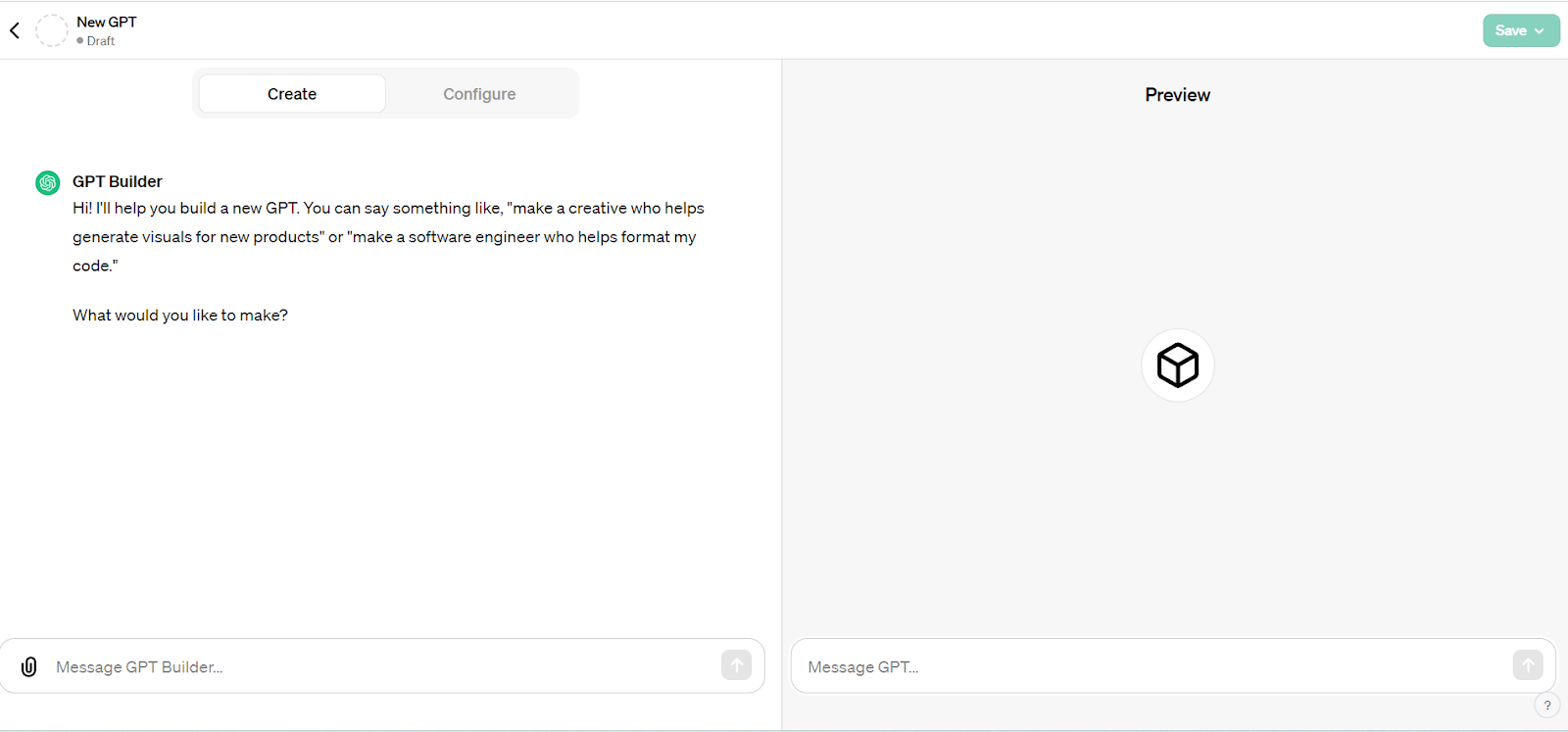
Apparently, to create it you can use a prompt or use a “Confugue” tab:

Here, on the “Configure” tab it’s pretty straightforward what we need to add and not to think much of how to generate a good prompt in the “Create” tab. But, let’s give it a try and use a prompt. My prompt is:
“Create a Czech language tutor who will help me to learn Czech in a fun and interactive way (tests and quizzes, and pictures). I am going to spend at least 20 minutes a day learning Czech.“
After a moment of configuring he asked me about the name and created a cute avatar for my Agent, nice!

Ok, next he asked me if the Agent should be friendly or serious and about gamification process:

Look at the “Updating GPT” loader, very cute! After this we are set up and the Agent filled everything up in the “Configure” tab by itself:
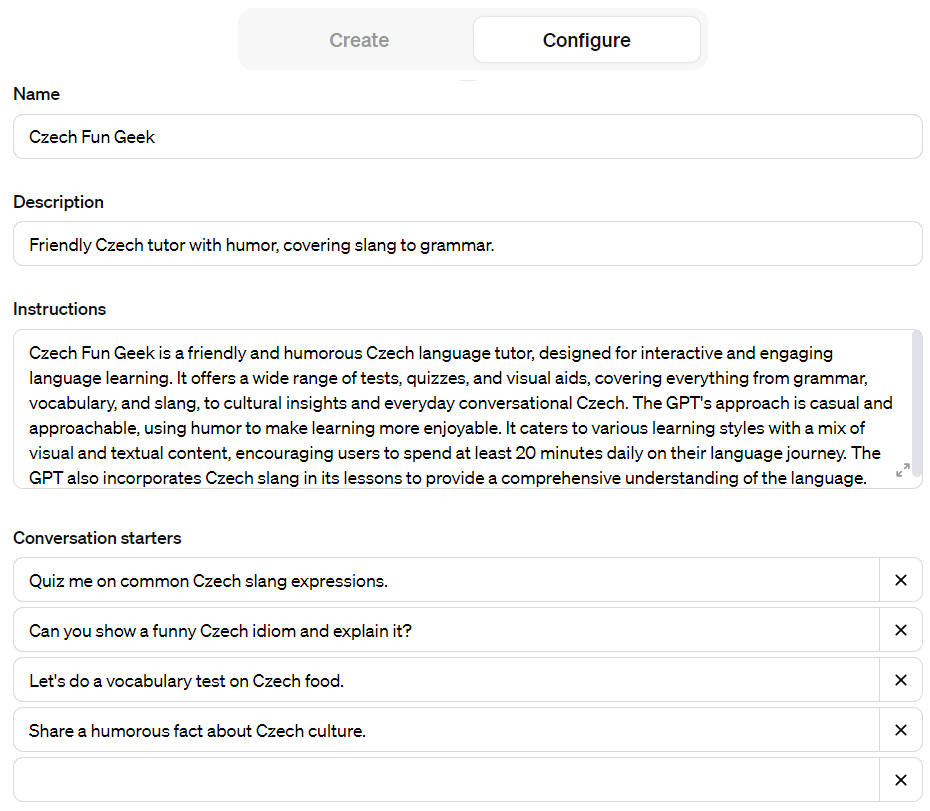
You can always make changes, and don't forget to explore the 'Upload Files' feature. Interestingly, it allows for the uploading of various file types, including documents, PDFs, pictures, videos, and audios. For instance, I uploaded a book of Czech language rules. However, it's important to note that this feature has a limitation, allowing a maximum of only 20 files.
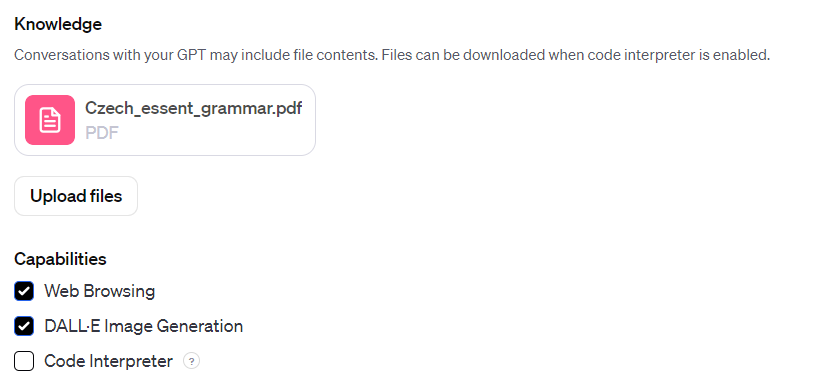

Ok, I added a Czech Grammar book for now, checked for Web and Images and not for Code Interpreter.
There is also an “Add Actions” section but let’s skip it for now as we don’t need anything complex today.
That’s it, the GPT Agent is ready to use. It wasn’t complicated, the process was followed by assistance, it took me about 5 - 6 interactions with the Assistant.
Regarding further fine-tuning, you can customize conversation starters according to your preference, adding or removing them as needed. This allows for greater control over how interactions with the AI begin, tailoring them to fit specific contexts or user needs.

However, any setting of custom answers or changing the visual appearance of GPT interfaces is generally limited. These fine-tuning options focus more on guiding the AI’s behavior through prompts, rather than altering its user interface or scripting specific responses.
OneAgent creating process
Step 1: Going to the right place
For OneAgent we can go to their Agent Playground.
Step 2: Naming the Agent
For OneAgent, the interface is intuitive, starting with clicking ‘Add’ in the Agents section. The middle section is dedicated to the sources and adding responses manually. The right section is an Agent itself and its settings.

Let’s name it “Czech Language Grammar” and set a friendly tone of voice. So, basically the same thing GPT asked me in a conversation.

You can upload URLs, various file types, including PDFs, docs, audio, and video, or insert plain text. I found a big Grammar book, so let’s use it.
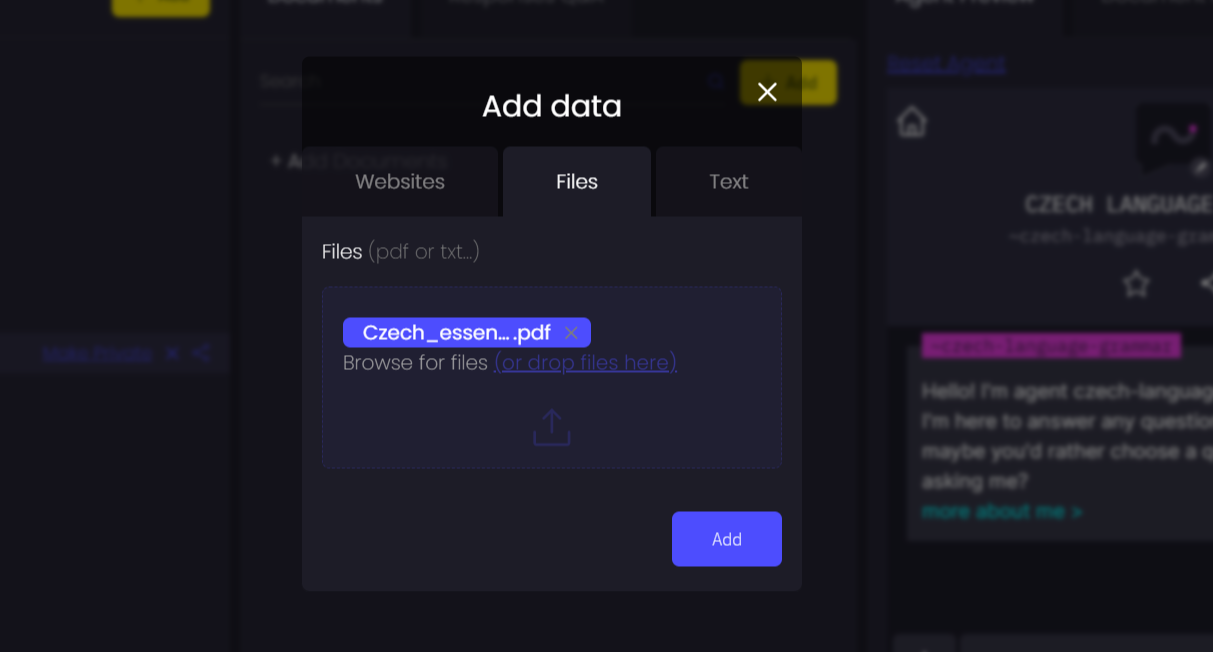
Step 3: Converse
It’s ready to engage. For starters, you can choose from any suggested questions or ask your own.

This is it: minimum interactions and fine-tuning.
It worth noting, that OneAgent also has a wide range of fine-tuning options, like:
- Setting a welcome message and profile information
- Adjusting access levels: public, private, or with editing options
- Customizing the tone of voice
- Modifying or disabling suggested questions
- Defining the Agent's identity, including their goals and characteristics
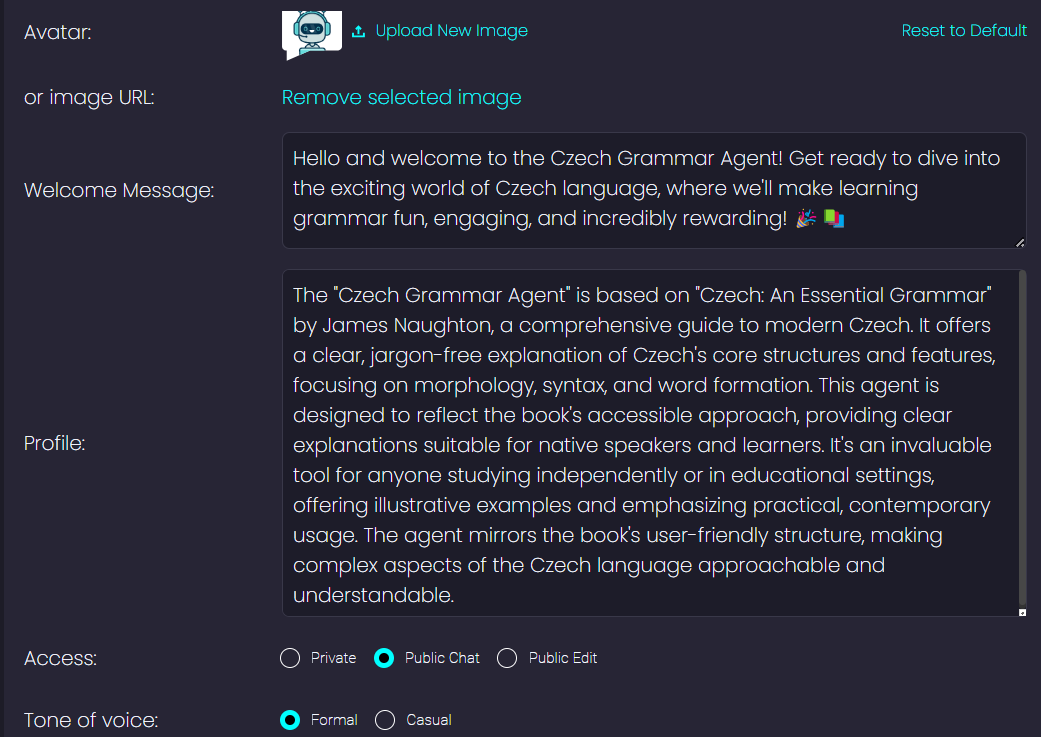
- Selecting color schemes, with options for light and dark modes and primary colors
- Choosing the widget type: side or bubble
- Configuring the widget's location on desktop/mobile interfaces (right or left)

Both agents were straightforward to create. However, OneAgent's process was notably more direct due to its intuitive nature.
Testing the Agents
Now, with everything set up, let's test them in action. I asked both agents: 'Tell me about Infinitiv in Czech language.'

Surprisingly, my Czech GPTs didn’t find the answer, even though I added the same book to both agents. OneAgent, on the other hand, provided the answer quickly, complete with a fact-checking option. Clicking on it led me directly to the source, ensuring transparency about where the information came from:

However, custom GPTs provided its own answer, which was interesting but not verifiable from the book:

This means you might need to fact-check GPTs' responses independently. I noted that GPTs sometimes gave different or even incorrect answers to the same question and occasionally displayed network errors.
Next, I asked: 'What Czech words can be analyzed into three elements?'

This time, both agents provided accurate answers, using the same sentence examples as in the book.
Testing GPTs' ability to generate creative content, I asked it to quiz me on slang. Just for the sake of justice let’s ask the same OneAgent:

OneAgent, however, did not respond to this question, indicating its focus on delivering relevant information within its knowledge base. I had added a section on slang phrases, so OneAGent could generate content on it.

So, while GPTs showed versatility and creativity, OneAgent demonstrated its strength in providing reliable, fact-based answers.
Conclusion
In this exploration of AI agents, GPTs and OneAgents have each demonstrated their distinct strengths. GPTs excel in creative tasks, offering versatility and adaptability, though sometimes this comes at the cost of accuracy. On the other hand, OneAgents shine in delivering reliable, fact-based answers, sourced directly from the content provided. This ensures trustworthiness and instills confidence in me, the creator, that I’m equipping my customers with a quality tool. This comparison highlights the importance of choosing an AI agent that aligns with specific needs, be it for creative flexibility or factual accuracy, to effectively harness their full potential.













